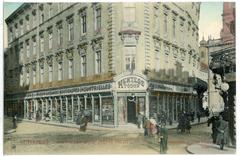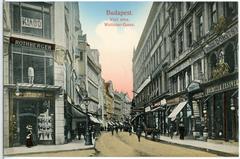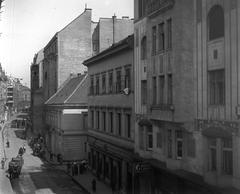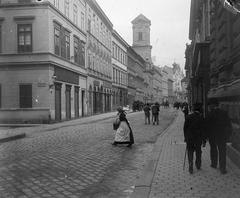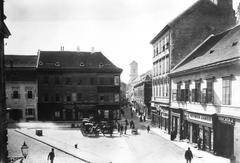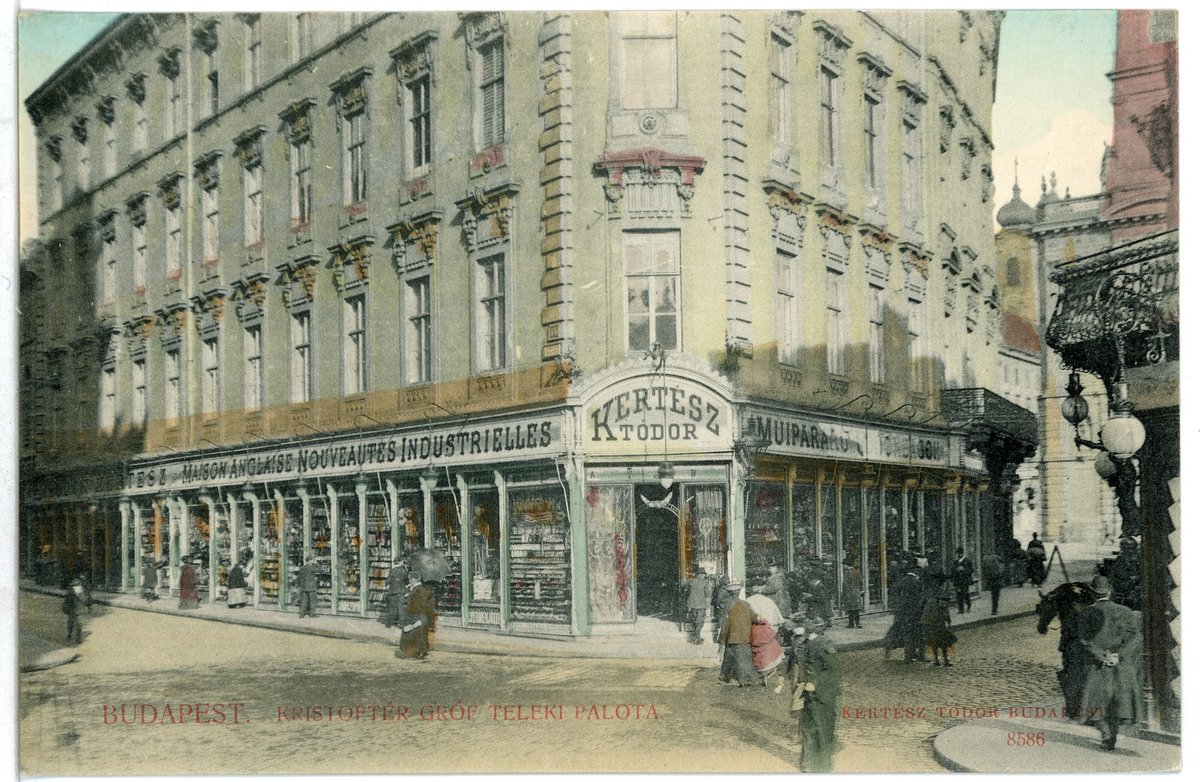
Váci Street Budapest: Visiting Hours, Tickets, and Attractions Guide
Date: 14/06/2025
Introduction
Váci Street (Váci utca) is one of Budapest’s most celebrated pedestrian promenades—a vibrant nexus where historic grandeur meets contemporary urban life. Stretching from the bustling Vörösmarty Square to the striking Great Market Hall, this nearly two-kilometer thoroughfare encapsulates centuries of architectural evolution, cultural significance, and commercial vitality. Whether you are a history enthusiast, a lover of architecture, a shopping aficionado, or a casual traveler, Váci Street offers a sensory-rich experience at the heart of Hungary’s capital (budapest.net, holidify.com, budapest.yourcityvisit.com).
Contents
- Introduction
- Historical Overview
- Medieval Origins
- 18th–19th Century Transformation
- 20th Century and Modern Revival
- Architectural Highlights and Notable Buildings
- Visiting Information
- Opening Hours
- Tickets and Guided Tours
- Accessibility and Directions
- Key Attractions and Landmarks
- Shopping, Dining, and Nightlife
- Cultural Events and Photo Spots
- Visitor Tips and FAQs
- Conclusion
- References
Historical Overview
Medieval Origins
Váci Street’s roots reach back to medieval Budapest, when it followed the line of the old city wall and served as a vital commercial artery. The street led directly to one of the city gates—now replaced by Vörösmarty Square—linking the inner city with the Danube and facilitating trade and urban growth (budapest.net).
18th–19th Century Transformation
As Pest flourished during the 18th century, Váci Street became a sought-after address among the city’s elite. Grand residences and elegant facades in late Baroque and early Neoclassical styles began to line the boulevard. The 19th century marked the street’s emergence as a hub of social and commercial life, with the construction of ornate mansions and shops reflecting the prosperity of the Austro-Hungarian era (budapest.net, holidify.com).
20th Century and Modern Revival
By the 1900s, Váci Street had cemented its status as Budapest’s premier shopping street with luxury boutiques, cafes, and vibrant street life. The post-war socialist era shifted its commercial landscape to state-run stores, but after 1989, international brands and extensive restoration revitalized the street, making it a cosmopolitan centerpiece that attracts millions each year (travelguidebudapest.com).
Architectural Highlights and Notable Buildings
Váci Street is a living showcase of architectural styles:
- Neoclassical Foundations: Symmetrical facades and classical elements dominate many early buildings, especially in the northern section (trip-to-hungary.com).
- Art Nouveau Flourishes: Ornate ironwork, organic motifs, and colorful ceramics from the early 20th century are visible in landmarks like the Thonet House (qeepl.com).
- Neo-Renaissance Grandeur: The City Hall (Nos. 62–64) demonstrates the street’s late 19th-century aspirations.
- Baroque Heritage: Churches such as St. Michael’s display decorative baroque elements.
Notable Buildings:
- Thonet House (Váci utca 11): Art Nouveau facade.
- Hermes House (Váci utca 16): Elaborate stucco and historic significance.
- Párisi Udvar: A blend of Art Nouveau and Neo-Gothic architecture, now a luxury hotel and shopping arcade (Párisi Udvar Hotel).
- Great Market Hall (Nagyvásárcsarnok): Neo-Gothic market at the southern end (Great Market Hall).
- Inner City Parish Church: Mix of Romanesque, Gothic, and Baroque styles (Budapestinfo.hu).
Visiting Information
Opening Hours
- Street: Open 24/7 as a public pedestrian area.
- Shops/Cafés: Typically 10:00 AM to 8:00 PM, though some may vary.
- Markets/Attractions: Great Market Hall is open 6:00 AM–6:00 PM (closed Sundays).
Tickets and Guided Tours
- Access: Free to walk the street.
- Attractions: Entry to some museums, galleries, or theatres may require tickets.
- Guided Tours: Numerous walking tours focusing on history, architecture, and gastronomy are available for booking online or at local tourist offices (budapestbylocals.com).
Accessibility and Directions
- Metro: Vörösmarty tér (M1), Ferenciek tere (M3), Fővám tér (M4).
- Tram/Bus: Multiple lines serve both ends of the street.
- Mobility: The area is flat, pedestrianized, and largely wheelchair accessible, with accessible shops and restrooms near main squares.
Key Attractions and Landmarks
- Vörösmarty Square: Northern gateway, site of the annual Christmas Market and Gerbeaud Café (Gerbeaud Café).
- Fővám Square: Southern end, adjacent to the Great Market Hall.
- Hermes Fountain: Art Deco monument, a favorite photo spot.
- Danube Promenade: Panoramic river views and the Little Princess Statue (Budapest.com).
- Pesti Theatre: Cultural venue blending old and modern design.
Shopping, Dining, and Nightlife
- Shopping: International brands (Zara, H&M, Mango, Swarovski) and Hungarian boutiques (Nanushka, Cserpes Tejivó).
- Dining: Classic cafés (Gerbeaud), traditional Hungarian restaurants (Fatal Restaurant), and street food stalls (Fatal Restaurant).
- Nightlife: Ruin bars nearby in the Jewish Quarter (Szimpla Kert) and live performances at the Budapest Operetta Theatre (Szimpla Kert, Budapest Operetta Theatre).
Cultural Events and Photo Spots
- Christmas Market: Central Europe’s largest, held annually at Vörösmarty Square (Budapest Christmas Fair).
- Seasonal Festivals: Open-air concerts and art shows in summer.
- Photo Opportunities: Historic facades, Hermes Fountain, and Danube views at dusk.
Visitor Tips and FAQs
- Wear comfortable shoes for cobblestone streets.
- Watch for pickpockets in crowded areas.
- Early mornings or weekdays are less crowded.
- Public restrooms are available near major squares.
Frequently Asked Questions
Q: Is Váci Street free to visit?
A: Yes, it’s a public street. Some attractions may charge entry.
Q: What are typical shop opening hours?
A: Most shops open around 10:00 AM and close between 7:00–9:00 PM.
Q: Is Váci Street safe at night?
A: Yes, thanks to high foot traffic and regular police patrols.
Q: Are guided tours available?
A: Yes, various themed tours can be booked online or at tourist offices.
Q: Is the street accessible for wheelchairs?
A: The main promenade is, though some older buildings have limited access.
Conclusion
Váci Street is a cornerstone of Budapest’s historical, cultural, and commercial life. Its blend of medieval origins, architectural diversity, lively shopping, and rich café culture makes it a must-visit for every traveler. Plan your visit during daylight to admire the architecture and enjoy bustling commerce, or come in the evening for festive markets and vibrant nightlife. Use official resources and tools like the Audiala app for interactive guides and real-time updates. Whether you’re on a self-guided stroll or an expert-led tour, Váci Street is your gateway to the heart of Budapest (travelguidebudapest.com, budapestinfo.hu, budapestbylocals.com).
Explore More: Download the Audiala app for guided tours, insider tips, and the latest event updates. Follow us on social media for travel inspiration and insights into Budapest’s best attractions.
References
- Váci utca, Budapest.net, 2024
- Váci Street Sightseeing, Holidify, 2024
- Váci Street Budapest, Your City Visit, 2024
- Váci Street Guide, Travel Guide Budapest, 2024
- Váci Street Budapest, Budapestinfo.hu, 2024
- Váci Street Budapest by Locals, 2024
